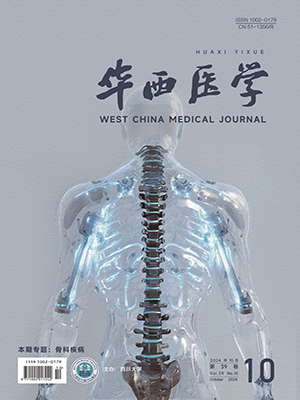| 1. |
Stupp RR, Mason WP, van den Bent MJ, et al. Radiotherapy plus concomitant and adjuvant temozolomide for glioblastoma[J]. N Engl J Med, 2005, 352 (10): 987-996.
|
| 2. |
Macdonald DR, Cascino TL, Schold SC Jr, et al. Response criteria for phase II studies of supratentorial malignant glioma[J]. J Clin Oncol, 1990, 8(7): 1277-1280.
|
| 3. |
Kleinschmidt-DeMasters BK, Geier JM. Pathology of high-dose intraarterial BCNU[J]. Surg Neurol, 1989, 31(6): 435-443.
|
| 4. |
Fiegler W, Langer M, Scheer M, et al. Reversible computed tomographic changes following brain tumor irradiation induced by the "early-delayed reaction" after radiation[J]. Radiologe, 1986, 26(4): 206-209.
|
| 5. |
Watne K, Hager B, Heier M, et al. Reversible oedema and necrosis after irradiation of the brain. Diagnostic procedures and clinical manifestations[J]. Acta Oncol, 1990, 29(7): 891-895.
|
| 6. |
Griebel M, Friedman HS, Halperin EC, et al. Reversible neurotoxicity following hyperfractionated radiation therapy of brain stem glioma[J]. Med Pediatr Oncol, 1991, 19(3): 182-186.
|
| 7. |
Chamberlain M, Glantz M, Chalmers L, et al. Early necrosis following concurrent Temodar and radiotherapy in patients with glioblastoma[J]. J Neurooncol 2007, 82(1): 81-83.
|
| 8. |
Taal W, Brandsma D, de Bruin HG, et al. Incidence of early pseudoprogression in a cohort of malignant glioma patients treated with chemoirradiation with temozolomide[J]. Cancer, 2008, 113(2): 405-410.
|
| 9. |
Brandes AA, Franceschi E, Tosoni A, et al. MGMT promoter methylation status can predict the incidence and outcome of pseudoprogression after concomitant radiochemotherapy in newly diagnosed glioblastoma patients[J]. J Clin Oncol, 2008, 26(13): 2192-2197.
|
| 10. |
Hegi ME, Diserens AC, Gorlia T, et al. MGMT gene silencing and benefit from temozolomide in glioblastoma[J]. N Engl J Med, 2005, 352(10): 997-1003.
|
| 11. |
Prados MD, Chang SM, Butowski N, et al. Phase II study of erlotinib plus temozolomide during and after radiation therapy in patients with newly diagnosed glioblastoma multiforme or gliosarcoma[J]. J Clin Oncol, 2009, 27(4): 579-584.
|
| 12. |
Rodemann HP, Blaese MA. Responses of normal cells to ionizing radiation[J]. Semin Radiat Oncol, 2007, 17(2): 81-88.
|
| 13. |
Nordal RA, Nagy A, Pintilie M, et al. Hypoxia and hypoxia-inducible factor-1 target genes in central nervous system radiation injury: a role for vascular endothelial growth factor[J]. Clin Cancer Res, 2004, 10: 3342-3353.
|
| 14. |
Gupta VK, Jaskowiak NT, Beckett MA, et al. Vascular endothelial growth factor enhances endothelial cell survival and tumor radioresistance[J]. Cancer J, 2002, 8 (1): 47-54.
|
| 15. |
Brandes AA, Rigon A, Zampieri P, et al. Carboplatin and teniposide concurrent with radiotherapy in patients with glioblastoma multiforme: a phase II study.[J]. Cancer 1998, 82(2): 355-361.
|
| 16. |
Mullins ME, Barest GD, Schaefer PW, et al. Radiation necrosis versus glioma recurrence: conventional MR imaging clues to diagnosis[J]. AJNR Am J Neuroradiol, 2005, 26: 1967-1972.
|
| 17. |
Kumar AJ, Leeds NE, Fuller GN, et al. Malignant gliomas: MR imaging spectrum of radiation therapy-and chemotherapy-induced necrosis of the brain after treatment[J]. Radiology, 2000, 217: 377-384.
|
| 18. |
Sugahara T, Korogi Y, Tomiguchi S, et al. Posttherapeutic intraaxial brain tumor: the value of perfusion-sensitive contrast-enhanced MR imaging for differentiating tumor recurrence from nonneoplastic contrast-enhancing tissue[J]. AJNR Am J Neuroradiol, 2000, 21(5): 901-909.
|
| 19. |
Teksam M, Kayahan EM, Yerli H, et al. Brain MR perfusion and MR spectroscopy in differentiation of radiation necrosis from tumor recurrence (case report)[J]. Tani Girisim Radyol, 2004, 10(4): 263-267.
|
| 20. |
Shimizu H, Kumabe T, Tominaga T, et al. Noninvasive evaluation of malignancy of brain tumors with proton MR spectroscopy[J]. AJNR Am J Neuroradiol, 1996, 17(4): 737-747.
|
| 21. |
Vigneron D, Bollen A, McDermott M, et al. Three dimensional magnetic resonance spectroscopic imaging of histologically confirmed brain tumors[J]. Magn Reson Imaging, 2001, 19(1): 89-101.
|
| 22. |
Rock JP, Scarpace L, Hearshen D, et al. Associations among magnetic resonance spectroscopy, apparent diffusion coefficients, and image-guided histopathology with special attention to radiation necrosis[J]. Neurosurgery, 2004, 54(5): 1111-1117.
|
| 23. |
Chen W. Clinical applications of PET in brain tumors[J]. J Nucl Med, 2007, 48 (9): 1468-1481.
|
| 24. |
Ricci P, Karis J, Heiserman J, et al. Differentiating recurrent tumor from radiation necrosis: time for reevaluation of positron emission tomography[J] ? AJNR Am J Neuroradiol, 1998, 19(3): 407-413.
|
| 25. |
Terakawa Y, Tsuyuguchi N, Iwai Y, et al. Diagnostic accuracy of 11C-methionine PET for differentiation of recurrent brain tumors from radiation necrosis after radiotherapy[J]. J Nucl Med, 2008, 49(5): 694-699.
|
| 26. |
Vredenburgh JJ, Desjardins A, Herndon JE II, et al. Phase II trial of bevacizumab and irinotecan in recurrent malignant glioma[J]. Clin Cancer Res, 2007, 13: 1253-1259.
|
| 27. |
Cloughesy TF, Prados MD, Wen PY, et al. A phase II, randomized, non-comparative clinical trial of the effect of bevacizumab (BV) alone or in combination with irinotecan (CPT) on 6-month progression free survival (PFS6) in recurrent, treatment-refractory glioblastoma (GBM)[J]. J Clin Oncol, 2008, 26 (Suppl).
|
| 28. |
Gonzalez J, Kumar AJ, Conrad CA, et al. Effect of bevacizumab on radiation necrosis of the brain[J]. Int J Radiat Oncol Biol Phys, 2007, 67(2): 323-326.
|




